4-out 1-in situations
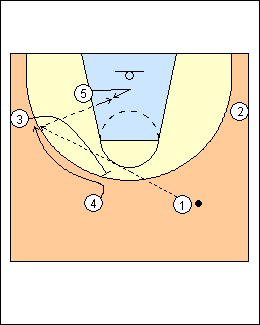 | 1 Jeff Bauer, and others Catch-up motion (when behind) Attack with dribble penetration and exaggerated spacing (drive for the foul at home, drive and kick on the road). Late-game motion may include: - set combination screens for shooters (e.g. a staggered or double screen) - program European curls, drifts, and a post sequence out of transition - dribble weave or hand-offs for deep penetration and creating mismatches - quick post feeds off swings (shown) - flatten the defence on the baseline for deeper penetration and larger gaps - when the ball is skipped to a weakside player on the third side or later in the possession, he must look to drive or shoot (third-side rule) - clear the gap - to vacate the primary helper on a middle drive by a wing, the swing player closest to the ball basket or corner cuts - send 4 or 5 players to the offensive boards. |
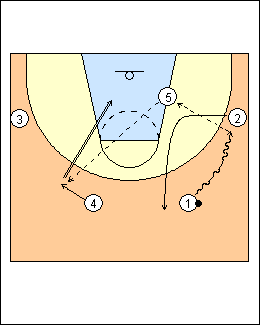 | 2 Slow-down motion (when leading) - be patient, take great shots - get the ball to your franchise player, create situations for him to get easy shots - shoot only after a set number of sides, passes, or time off the shot clock (except open layups) - the ball must be thrown into the post one or more times before a perimeter shot - specify scoring options, e.g., only shoot after a post feed, or a curl by the best cutter - have the best ballhandlers and free-throw shooters set rear screens, they will get the ball on out cuts. |
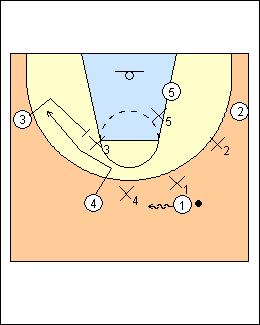 | 3 Switching defence - screeners slip to the basket or to an open area - widen the screens, more space for screeners to slip - screen your own man, opening up the cutter (shown) - cutters backcut just before getting to the screen - cutters curl screens, opening up the screener (second cutter) - little-big screens create mismatches (go to the perimeter mismatch, your team is used to dribble-kick) - use combination screens (staggered, double) - solid offensive rebounding. Brad Brownell (pdf) (mensbasketballhoopscoop.blogspot.com) - use only post/perimeter screens (mismatch switch or no switch) to avoid frustration - post-perimeter pairs work on each side of the floor, optionally allow the point guard to replace 2 or 3 during a possession (e.g., with a shallow cut, UCLA cut, downscreen or flarescreen). - have players cut/move and get ball reversal 1-2 times then screen - set more flarescreens than downscreens, widen the floor for better spacing, the screener and passer always have eye contact, easier to slip the screen. Bob Huggins - if defenders switch, the screener slips the screen, or the cutter makes a switch cut, curling around the screen and screening for the screener, who curls and the initial cutter comes back to the ball. Rick Majerus (pdf) - if the defence switches a little-big screen, attack the defensive big on the perimeter because there are two likely foul scenarios - trying to keep the guard out front, and trying to keep the attacking big off the glass. On a little-to-big flarescreen, the big heads straight to the block on the switch to post the smaller defender (the screener does not slip the screen), the cutter also dives the switch on a like-sized flarescreen. Except on a tight curl by the cutter, screens against a switching defence should be broken off before the screener and cutter come together to avoid facilitating a switch. On a downscreen, the screener or cutter can break off and dive to the rim, or both players can (double chase). A lot of switching defences have trouble with a tight curl or backcut (the first look). |
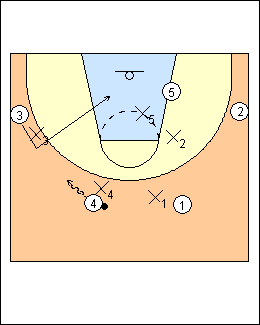 | 4 Pressure defence - spacing - take the defence out and up as far as they will defend, setting up backcuts - set physical screens early - use dribble-ats, come together hard (about 10 feet apart), the cutter shows a fist and cuts to the basket, the passer pass fakes outside (shown) - use dribble reversals to generate swings and dribble-ats - rear screens loosen perimeter defenders (especially from the post) and create pressure release on the out cut - flarescreens are also useful, but shorten the pass by dribbling up to the flare - staggered screens are tough for defenders to get through (the last screener should be a big to prevent switching) - slip screens - pass and shot fakes create driving and passing lanes - penetrate off swings and shot fakes, the defence is spread out - when an entry pass is denied, the post automatically flashes to the wing area for a pass - dribble loop against a team that denies entry passes, make a shallow loop around the elbow to the swing spot and then get a pass, receive a flarescreen, set a downscreen, or basket cut if denied. Brad Brownell - make them defend the basket - spread the floor, backcut, backscreen - organize 2-3 pressure releases, a dribble entry and off the pass [e.g., blind pig] - if denied, backcut don't stand - the low post stays on one side of the floor so one block area is always open for backcuts (or have both posts out on the floor) - step a low post out to the short corner (empty the low post), on a pass to the short corner the passer Laker cuts to the basket - backscreen for a passer - be ready to drive the ball aggressively, empty the low post (e.g., shallow cut to the elbow) - give teammates room to drive the ball, e.g., pass and ballside corner cut from the top, giving the ballhandler the middle of the floor to attack. Allison McNeill - a team that denies entry passes is susceptible to backcuts and backscreens. Dave Smart - if the defence is denying everywhere, your ballhandler should be the guy with a matchup. Dennis Felton - if the defence denies the perimeter, get the ball inside to 5, or put it on the floor and get to the rim. Roy Williams - if 5 works his butt off the defence won't pressure on the perimeter because he will kill them inside. |
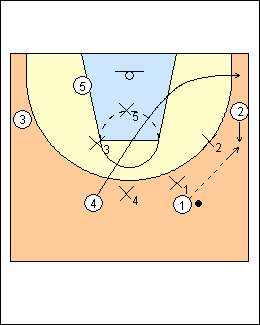 | 5 Trapping defence - space out, up and even down to make defensive slides as long as possible - on a pass to the wing, a player cuts to the ballside corner (corner or bulls cut, shown), usually not covered, but be ready to make a play from there - dribble penetration - pass and shot fakes - the post flashes to the wing area as pressure release - when trapped, look to the weakside - get the ball to a good athlete in the middle of the floor. Dave Odom - when double-teamed, the offence must get to a situation of three passes at once, and somebody has got to be in the middle of the court with their head on the line of the ball to the basket. |
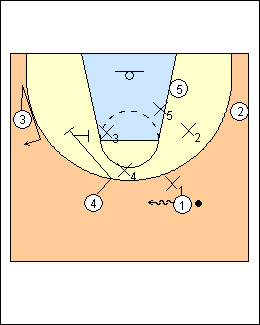 | 6 Pack defence - swing the ball, make the defence shift - basket cut to the rim then space out behind the defence - flarescreens (especially for the passer) generate swings - sagging defenders usually go ballside of screens, so turn downscreens and rearscreens into pinscreens to generate swings and open looks (shown) - against gap defenders, use European curls on dribble penetration (rotate behind the dribbler) - double screens. Brad Brownell - helpside (sag) defence - move the defence with ball reversal, player movement, early offence - use flarescreens, the defence usually jumps hard to the ball - screen in for a crosscourt skip pass - downscreen (screen in) for cutters coming to the weakside - reverse the ball and drive against recovering helpside defenders - penetrate and fill behind - drive it hard at a (sagging) shooter's defender, the shooter fills behind. Jerry Petitgoue - pass and screen away against sagging defence, screeners come back where they started. Allison McNeill - ballside flare screens and weakside pin screens are effective against a team that does not deny and sags tremendously on the weakside. |
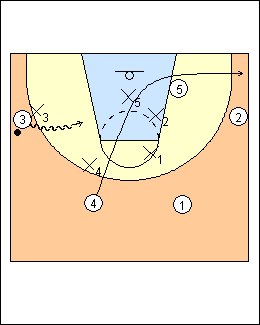 | 7 Funnel (force) middle - wing players space down to the mid-post for larger gaps and longer defensive slides on penetration - drive the ball to the middle from the wing immediately after a basket cut by the ballside swing player, clearing out the primary help (shown) - on middle penetration from a wing, weakside attackers space down and out, the ballside swing player looks to slide, curl or relocate because his defender is the helper - the post defender usually plays high side to help on penetration, cutters who space to the ballside corner can feed the post - post feeds via flarescreens are available because perimeter defenders are preoccupied with help on the ball, and flare passing angles are good due to availability of middle penetration - ballscreen on the baseline side, the defence is not used to defending baseline penetration. |
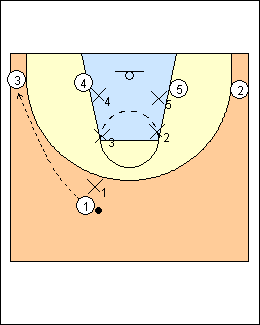 | 8 Junk defence - distort the defence by overloading areas of light coverage, e.g., put two attackers at the elbows against a triangle and two, four players on the baseline against a box and one (shown) - use as screeners the attackers who are guarded man-to-man, their defenders will not help on the screens - flarescreen the top defenders to get easy ball reversals and open looks - exploit poor corner coverage with ballscreens or pinscreens in the corner - send extra players to the boards. |
This page was made with Basketball playbook from Jes-Soft